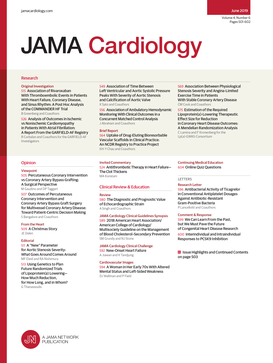单导联心电图对心力衰竭风险的人工智能预测
IF 14.8
1区 医学
Q1 CARDIAC & CARDIOVASCULAR SYSTEMS
引用次数: 0
摘要
尽管有改善疾病的治疗方法,可扩展的心力衰竭(HF)风险分层策略仍然难以捉摸。能够记录单导联心电图(ECGs)的便携式设备可以进行大规模的社区风险评估。目的评价人工智能(AI)算法能否预测噪声单导联心电图的心衰风险。设计、环境和参与者:在耶鲁纽黑文综合医疗系统(YNHHS)门诊常规心电图患者和英国生物银行(UKB)和巴西成人健康纵向研究(ELSA-Brasil)的前瞻性人群队列中进行了一项基线时无心衰个体的回顾性队列研究。数据分析时间为2023年9月至2025年2月。暴露ai - ecg定义的左心室收缩功能障碍(LVSD)风险。在有心电图的个体中,分离导联I心电图,并使用经过噪声适应的AI-ECG模型(模拟来自可穿戴设备的ECG信号)来识别LVSD。模型概率与新发HF(定义为首次HF住院)的关联进行了评估。采用Harrel C统计、综合判别改善和净重分类改善,将AI-ECG的鉴别与新发HF的2个风险评分(预防心力衰竭合并队列方程[PCP-HF]和预测心血管疾病事件风险方程[prevention])进行比较。结果共192 667例YNHHS患者(中位年龄56岁,41 ~ 69岁;11181名女性[57.7%]),4141名UKB参与者(中位[IQR]年龄65[59-71]岁;21795名女性[51.7%])和13454名elsa -巴西参与者(中位[IQR]年龄为51[45-58]岁;7348名女性[54.6%])基线心电图。在YNHHS患者中,3697例(1.9%)发生HF,平均IQR为4.6(2.8-6.6)年;在UKB患者中,46例(0.1%)发生HF,平均IQR为3.1(2.1-4.5)年;在ELSA-Brasil患者中,31例(0.2%)发生HF,平均IQR为4.2(3.7-4.5)年。LVSD的AI-ECG筛查结果阳性与HF的风险增加3- 7倍相关,模型概率每增加0.1,与年龄、性别、合并症和竞争死亡风险无关,整个队列的风险增加27% - 65%。AI-ECG对YNHHS新发HF的鉴别率为0.723 (95% CI, 0.694-0.752), UKB为0.736 (95% CI, 0.606-0.867), ELSA-Brasil为0.828 (95% CI, 0.692-0.964)。在整个队列中,将AI-ECG预测与PCP-HF和PREVENT方程相结合与更高的Harrel C统计量相关(除PCP-HF外,差异为0.080-0.107;除PREVENT外,差异为0.069-0.094)。与PCP-HF相比,AI-ECG的综合识别能力提高0.091 ~ 0.205,与PREVENT相比,AI-ECG的综合识别能力提高0.068 ~ 0.192;与PCP-HF相比,其净重分类改善率为18.2%至47.2%,与PREVENT相比为11.8%至47.5%。结论和相关性在跨国队列中,噪声适应AI-ECG模型使用导联心电图估计心衰风险,表明潜在的心衰风险分层策略需要使用可穿戴和便携式心电设备进行前瞻性研究。本文章由计算机程序翻译,如有差异,请以英文原文为准。
Artificial Intelligence–Enabled Prediction of Heart Failure Risk From Single-Lead Electrocardiograms
ImportanceDespite the availability of disease-modifying therapies, scalable strategies for heart failure (HF) risk stratification remain elusive. Portable devices capable of recording single-lead electrocardiograms (ECGs) may enable large-scale community-based risk assessment.ObjectiveTo evaluate whether an artificial intelligence (AI) algorithm can predict HF risk from noisy single-lead ECGs.Design, Setting, and ParticipantsA retrospective cohort study of individuals without HF at baseline was conducted among individuals with conventionally obtained outpatient ECGs in the integrated Yale New Haven Health System (YNHHS) and prospective population-based cohorts of the UK Biobank (UKB) and the Brazilian Longitudinal Study of Adult Health (ELSA-Brasil). Data analysis was performed from September 2023 to February 2025.ExposureAI-ECG–defined risk of left ventricular systolic dysfunction (LVSD).Main Outcomes and MeasuresAmong individuals with ECGs, lead I ECGs were isolated and a noise-adapted AI-ECG model (to simulate ECG signals from wearable devices) trained to identify LVSD was deployed. The association of the model probability with new-onset HF, defined as the first HF hospitalization, was evaluated. The discrimination of AI-ECG was compared against 2 risk scores for new-onset HF (Pooled Cohort Equations to Prevent Heart Failure [PCP-HF] and Predicting Risk of Cardiovascular Disease Events [PREVENT] equations) using the Harrel C statistic, integrated discrimination improvement, and net reclassification improvement.ResultsThere were 192 667 YNHHS patients (median [IQR] age, 56 [41-69] years; 111 181 women [57.7%]), 42 141 UKB participants (median [IQR] age, 65 [59-71] years; 21 795 women [51.7%]), and 13 454 ELSA-Brasil participants (median [IQR] age, 51 [45-58] years; 7348 women [54.6%]) with baseline ECGs. A total of 3697 (1.9%) developed HF in YNHHS over a median (IQR) of 4.6 (2.8-6.6) years, 46 (0.1%) in UKB over a median (IQR) of 3.1 (2.1-4.5) years, and 31 (0.2%) in ELSA-Brasil over a median (IQR) of 4.2 (3.7-4.5) years. A positive AI-ECG screening result for LVSD was associated with a 3- to 7-fold higher risk for HF, and each 0.1 increment in the model probability was associated with a 27% to 65% higher hazard across cohorts, independent of age, sex, comorbidities, and competing risk of death. AI-ECG’s discrimination for new-onset HF was 0.723 (95% CI, 0.694-0.752) in YNHHS, 0.736 (95% CI, 0.606-0.867) in UKB, and 0.828 (95% CI, 0.692-0.964) in ELSA-Brasil. Across cohorts, incorporating AI-ECG predictions alongside PCP-HF and PREVENT equations was associated with a higher Harrel C statistic (difference in addition to PCP-HF, 0.080-0.107; difference in addition to PREVENT, 0.069-0.094). AI-ECG had an integrated discrimination improvement of 0.091 to 0.205 vs PCP-HF and 0.068 to 0.192 vs PREVENT; it had a net reclassification improvement of 18.2% to 47.2% vs PCP-HF and 11.8% to 47.5% vs PREVENT.Conclusions and RelevanceAcross multinational cohorts, a noise-adapted AI-ECG model estimated HF risk using lead I ECGs, suggesting a potential HF risk-stratification strategy requiring prospective study using wearable and portable ECG devices.
求助全文
通过发布文献求助,成功后即可免费获取论文全文。
去求助
来源期刊

JAMA cardiology
Medicine-Cardiology and Cardiovascular Medicine
CiteScore
45.80
自引率
1.70%
发文量
264
期刊介绍:
JAMA Cardiology, an international peer-reviewed journal, serves as the premier publication for clinical investigators, clinicians, and trainees in cardiovascular medicine worldwide. As a member of the JAMA Network, it aligns with a consortium of peer-reviewed general medical and specialty publications.
Published online weekly, every Wednesday, and in 12 print/online issues annually, JAMA Cardiology attracts over 4.3 million annual article views and downloads. Research articles become freely accessible online 12 months post-publication without any author fees. Moreover, the online version is readily accessible to institutions in developing countries through the World Health Organization's HINARI program.
Positioned at the intersection of clinical investigation, actionable clinical science, and clinical practice, JAMA Cardiology prioritizes traditional and evolving cardiovascular medicine, alongside evidence-based health policy. It places particular emphasis on health equity, especially when grounded in original science, as a top editorial priority.
 求助内容:
求助内容: 应助结果提醒方式:
应助结果提醒方式:


